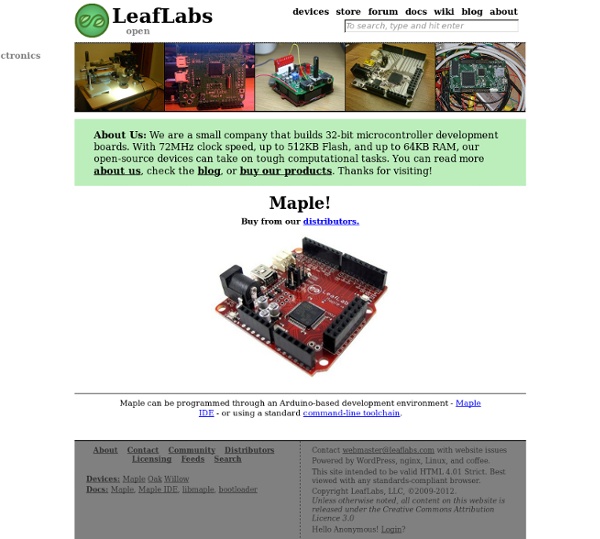



Cloud Engineering: Ship faster with better hardware engineering tools - Upverter Dangerous Prototypes · A new open source hardware project every month AC Light Dimmer - Andrew Jessop March 2006 This project came about because a friend of mine had something similar as a component for his final year electronic engineering project. We decided that we would have a kind of competition to see who could build an AVR based AC light dimmer the quickest. I was interested because I had always wanted to experiment with AC power control, and this was the perfect, simple little project. AC Dimming Theory Explanation to go here. Hardware Software The code for this project was written in BASCOM AVR - a BASIC compiler for the AVR microcontrollers. References Silicon Chip
Nuts and Volts | dms Travis Goodspeed's Blog Electronics Since my V-USB tutorials became popular, a recurring theme in the comments section have been people who are obviously motivated to try out the tutorial, but due to limited exposure to C language and command-line are either having trouble following my short instructions to compile the example .hex files, or being scared of the command-line, have tried to use AVR Studio instead, and fail. I have to admit that first I was a bit annoyed by these people – why are they trying to follow a challenging project, when they seemingly have no understanding of how command line, makefiles, C compiler and linking process works? Then, comment by comment, I finally realized that not everyone started coding in the nineties where you launched Windows 3.11 mostly to play Solitaire, and biggest thing in coding productivity was 80×50 text mode which allowed you to have 16-color hacking bliss in your Borland Turbo C++ 3.0 IDE (or RHIDE, after DJGPP came around). The first one is really easy.
Charlieplexing LEDs- The theory This instructable is less a build you're own project and more a description of the theory of charlieplexing. It's suitable for people with the basics of electronics, but not complete beginners. I've written it in response to the many questions I've gotten in my previously published Instructables. What is 'Charlieplexing'? It is driving lots of LEDs with only a few pins. In case you're wondering Charlieplexing is named after Charles Allen at Maxim who developed the technique. This can be useful for lots of things. Some other projects demonstrating charlieplexing you may want to look at are: How to drive a lot of LEDs from a few microcontroller pins. by Westfw :- And a couple of my own projects, The Microdot watch:- The Minidot 2 clock:- Another cool example of the use of charlieplexing is at:
How to Build a Homemade Clapper to Adjust the Lights and Set the Mood One night, I was trying to draw a circuit on a chalkboard, but it became too dark to see. The next day I bought a new lamp, only to find that the board gave off too much glare. I needed a light I could easily adjust. I could have just installed a dimmer, but where's the fun in that? As an engineer, I like to do projects that use a little electronics, a bit of mechanics and some software. My friends and I had been talking about those old '80s commercials for the Clapper, and it occurred to me that I could make a circuit that would dim the lights when I clapped my hands. Pretty much any lamp will do, but a DC-powered LED one works best. A Darlington transistor manages brightness by switching the light off and on an imperceptible 40,000 times a second. Download WinAVR for Windows or AVRDude for Mac, both of which are free, to get the clapper software from your computer to the programmer, which sends it to the microcontroller via a six-pin ISP connector.
Rutgers DCS HackerSpace Electronic amplifier A practical bipolar transistor amplifier circuit There are four basic types of electronic amplifier: the voltage amplifier, the current amplifier, the transconductance amplifier, and the transresistance amplifier. A further distinction is whether the output is a linear or nonlinear representation of the input. Amplifiers can also be categorized by their physical placement in the signal chain.[1] Figures of merit[edit] Amplifier quality is characterized by a list of specifications that includes: Amplifier types[edit] Amplifiers are described according to their input and output properties.[2] They exhibit the property of gain, or multiplication factor that relates the magnitude of the output signal to the input signal. The four basic types of amplifiers are as follows:[1] Voltage amplifier – This is the most common type of amplifier. In most cases an amplifier will be linear; that is, the gain is constant for any normal level of input and output signal. Power amplifier[edit] Klystrons[edit]